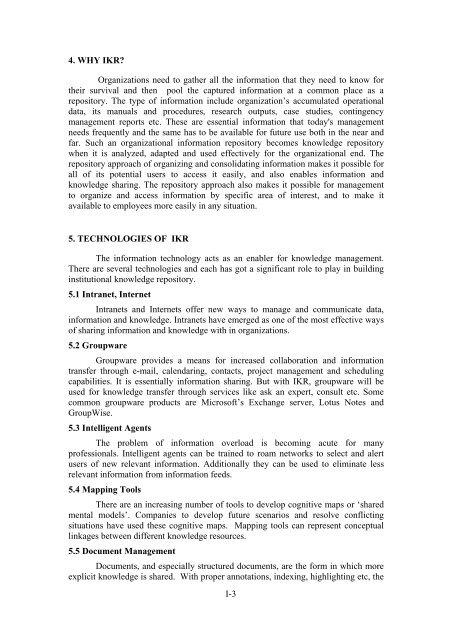READIT-2007 - Indira Gandhi Centre for Atomic Research
READIT-2007 - Indira Gandhi Centre for Atomic Research
READIT-2007 - Indira Gandhi Centre for Atomic Research
Create successful ePaper yourself
Turn your PDF publications into a flip-book with our unique Google optimized e-Paper software.
4. WHY IKR?<br />
Organizations need to gather all the in<strong>for</strong>mation that they need to know <strong>for</strong><br />
their survival and then pool the captured in<strong>for</strong>mation at a common place as a<br />
repository. The type of in<strong>for</strong>mation include organization’s accumulated operational<br />
data, its manuals and procedures, research outputs, case studies, contingency<br />
management reports etc. These are essential in<strong>for</strong>mation that today's management<br />
needs frequently and the same has to be available <strong>for</strong> future use both in the near and<br />
far. Such an organizational in<strong>for</strong>mation repository becomes knowledge repository<br />
when it is analyzed, adapted and used effectively <strong>for</strong> the organizational end. The<br />
repository approach of organizing and consolidating in<strong>for</strong>mation makes it possible <strong>for</strong><br />
all of its potential users to access it easily, and also enables in<strong>for</strong>mation and<br />
knowledge sharing. The repository approach also makes it possible <strong>for</strong> management<br />
to organize and access in<strong>for</strong>mation by specific area of interest, and to make it<br />
available to employees more easily in any situation.<br />
5. TECHNOLOGIES OF IKR<br />
The in<strong>for</strong>mation technology acts as an enabler <strong>for</strong> knowledge management.<br />
There are several technologies and each has got a significant role to play in building<br />
institutional knowledge repository.<br />
5.1 Intranet, Internet<br />
Intranets and Internets offer new ways to manage and communicate data,<br />
in<strong>for</strong>mation and knowledge. Intranets have emerged as one of the most effective ways<br />
of sharing in<strong>for</strong>mation and knowledge with in organizations.<br />
5.2 Groupware<br />
Groupware provides a means <strong>for</strong> increased collaboration and in<strong>for</strong>mation<br />
transfer through e-mail, calendaring, contacts, project management and scheduling<br />
capabilities. It is essentially in<strong>for</strong>mation sharing. But with IKR, groupware will be<br />
used <strong>for</strong> knowledge transfer through services like ask an expert, consult etc. Some<br />
common groupware products are Microsoft’s Exchange server, Lotus Notes and<br />
GroupWise.<br />
5.3 Intelligent Agents<br />
The problem of in<strong>for</strong>mation overload is becoming acute <strong>for</strong> many<br />
professionals. Intelligent agents can be trained to roam networks to select and alert<br />
users of new relevant in<strong>for</strong>mation. Additionally they can be used to eliminate less<br />
relevant in<strong>for</strong>mation from in<strong>for</strong>mation feeds.<br />
5.4 Mapping Tools<br />
There are an increasing number of tools to develop cognitive maps or ‘shared<br />
mental models’. Companies to develop future scenarios and resolve conflicting<br />
situations have used these cognitive maps. Mapping tools can represent conceptual<br />
linkages between different knowledge resources.<br />
5.5 Document Management<br />
Documents, and especially structured documents, are the <strong>for</strong>m in which more<br />
explicit knowledge is shared. With proper annotations, indexing, highlighting etc, the<br />
I-3

















